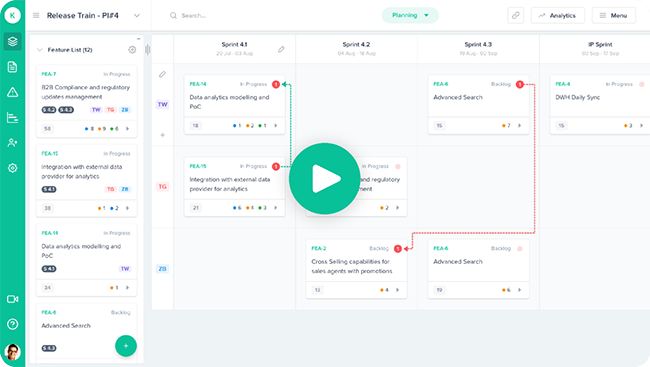Kendis is a digital solution for PI, Tribe and Big room Planning that works on top of Jira and Azure Boards.

The Spotify agile model is gaining recognition among fast-growing organisations. It has set the bar equally for startups and established organisations who focus on innovation, creativity and rapid delivery of work to the market, rather than growing the management layer.
At the squad level, teams choose an agile model of their own. They try to adapt it to fit the way they presently work. They strive for ways to deliver periodically with the least amount of dependencies and by minimizing risks. Each squad team is using an agile lifecycle management tool and wants to keep using it. But as soon the size of the company expands and more teams join, complexity increases across the organization.
In the previous blog, we discussed the structure of Spotify’s Organization. Here we uncover the challenges of scaling teams using the Spotify model and how they get complexity working for them.
1. Squads Alignment Towards Product Strategy
A key principle for every squad in the Spotify Agile Model. Each Squad has its own mission but it needs to be aligned with the product strategy, and organizational priorities. To eliminate the risk of getting too much focus on the squad’s mission and neglecting overall product strategy, right alignment is needed.
Teams need a way to synchronize the progress of all the squads of a tribe with the product management and stakeholders. To ensure this alignment and collaboration, Kendis presents an effective solution.
By using the Spotify Agile Model template in Kendis, squads and product managers can align and track their work’s progress. This is done by planning features and user stories on the Flex Board and by using webhooks to sync data with an agile team tool.

In some organisations, Chapter and Tribe Leads can make their own flex board to clarify the squads’ work alignment with the common vision and strategy.
2. Release Planning and Tracking
The Spotify Agile Model is efficient in keeping the speed of the development steady thereby teams release quicker. But what if a feature is missed and never becomes a part of a release? Again, Kendis is the solution.
Kendis comes into the picture, enabling fast planning and clean tracking of these releases. It presents a visualization of all the planned and the actual contents of the release train.
3. Managing Dependencies
Dependencies exist, regardless of how the Spotify agile model works to minimize it and even if the features are kept independent of each other as much as possible.
Dependencies need to be visible. Squad leaders take care of problematic dependencies, especially blocking and cross-tribe dependencies. If they are not identified earlier this can often lead to reprioritization and reorganization of architectural changes or technical solutions.
Kendis clearly shows the mapped dependencies. The status for each dependency can be set and can be represented by different colors. This enhances management and visibility into the entire project.
If there is a need of coordination to discuss dependencies then the Kendis dependency mapping board is a great help. Dependency mapping guides the squads where the problem is. The Situation may get awry when it comes to dependency alignment among squads, chapters and tribes. To handle technical and product dependencies among tribes, Kendis helps to manage and make them work well by providing the clear picture of the threads.
4. Chapter Lead Engagement
Chapter leads meet periodically in person with their team members. This is to understand and support the team's members to achieve their goals.
Leads have difficulties in obtaining a big picture of the Individual Squad product strategy and its progress. The chapter lead could only plan better and guide their team members if they are aware of their team’s capacity. Especially, when chapter members are working in different squads.
In Kendis, anyone can make a separate board and add members of their team. In this case, chapter lead can use this to discuss progress with members in real time. They can address the challenges and the problems that the team is going through.
5. Syncing for Scrum of Scrums
To handle dependencies and mitigate risks, scrum masters gather to resolve issues among squads. This syncing is made easy with the Kendis board where they can discuss issues by looking at the big picture supported by real-time data that is fetched from each squad's daily task management tool.
6. Align Architecture Changes
Tracking architectural issues is necessary. In Kendis, a chief architect can make a board to track architectural requirements and enforce these in accordance to the program vision. These requirements are added to the portfolio board after discussing them with the product management. In another team, system owners get the benefit of these architectural requirements and visualising its dependencies with the product features and value stream.
7. Drive Value With Lean Thinking
Teams using Kendis are extremely content. They are at ease when changing strategy, architecture, process, organisation or feature set. Kendis offers integration with multiple Agile Lifecycle Tools that seamlessly allows them to sync the progress of squads, tribes and the entire alliance. For now, squads were using Jira Software as their daily project management tool and Kendis integrated well to sync data with Jira.
Kendis provides insight into handling and managing dependencies and product management.
It is flexible and customizable in supporting any organizational structure. It does not restrict its users to a specific workflow.
To learn more about Kendis, Contact Us.









